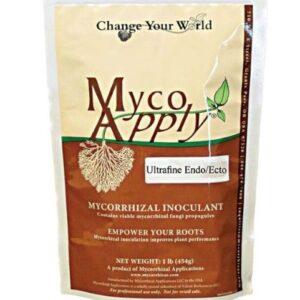History
During the late 1950’s and early 1960’s, Integrated Pest Management (IPM) was an approach to field crop management that farmers increasingly began to practice in the United States. It took barely a decade for farm agriculture to fully realize the problems associated with the over-reliance on pesticides when controlling pests. The classic example of the overuse of the chlorinated hydrocarbon (DDT) immediately comes to mind. Despite the astonishing success that synthetic pesticides usually have at killing pests, some have failed with disastrous results. This especially has occurred when the same material was used repeatedly over extended periods of time. For this reason, the IPM approach became necessary for US farmers managing extensive row crops. Approximately 20-25 years after farmers began implementing IPM methods, the landscaping or “green industry” started to gradually incorporate IPM methods into their service programs.

US Agriculture initially began to practice IPM with extensive row crop farming more than 60 years ago. (Photo Credit: Steven K. Rettke, Rutgers Coop. Ext.)
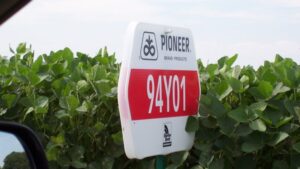
The use of GMO’s with crops such as Round-Up Ready soybeans & corn is certainly an IPM tactic, but emerging complications are a concern. (Photo Credit: Steven K. Rettke, Rutgers Coop. Ext.)
Throughout much of the 1980’s, many arborists associated with International Society of Arboriculture (ISA) at least initially made some attempts to market IPM services to their clients. For a variety of reasons, many of these arborists experienced only limited success selling IPM. It was concluded that to the average client, IPM did not have name recognition. Additionally, the term “IPM” sounded unattractive. The word “integrated” seemed too technical and too much emphasis was given to the negative word “pest.” Therefore, in 1989, the ISA decided to adopt a new term to introduce to their clients and discontinued actively marketing the IPM acronym. The new marketing catchphrase adopted was called Plant Health Care (PHC) with the hope that it would eliminate some of the negative “feelings” that the average client may have had with IPM.
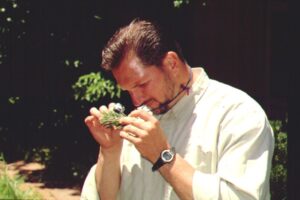
IPM requires the close monitoring for insect/disease pests. The use of a hand-lens is essential. (Photo Credit: Steven K. Rettke, Rutgers Coop. Ext.)
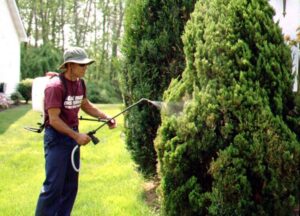
IPM attempts to apply selective pest treatments where they are needed. (Photo Credit: Steven K. Rettke, Rutgers Coop. Ext.)
Separation?
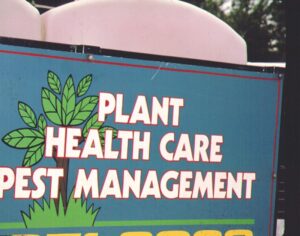
Some landscape companies have attempted to be all inclusive & have it both ways. (Photo Credit: Steven K. Rettke, Rutgers Coop. Ext.)
With the separation between IPM and PHC practitioners (at least in name), the obvious question is whether there exists a true difference in meaning and practice between these two terms? It is a reasonable argument to suggest that PHC is a term that is more understandable to the average client. Does PHC equal IPM or does the name change represent more than just a new marketing angle?
When defining PHC, it is generally stated to be a holistic approach to maintaining plant vigor and health. PHC typically focuses on services such as mulching, fertilizing, pruning, take-downs and more recently the use of bio-stimulants and mycorrhizae. The PHC philosophy also extends into areas of appropriate selection of landscape plants, their placement and the use of pest resistant plants. Client consultation concerning the health and vitality of their plants is the focus

PHC emphasizes an holistic approach to maintaining plant vigor & health. It typically focuses on services such as mulching, fertilizing & pruning. (Photo Credit: Steven K. Rettke, Rutgers Coop. Ext.)
IPM, on the other hand, has historically concentrated on the management of the pest in the system. It is metaphorically stated by some that PHC is an umbrella and IPM is a subset that lies under it. The PHC focus on the plant in the landscape is certainly different than the IPM focus on the pest in monoculture farming. However, the urban landscape is not row-crop farming and although the name IPM was borrowed from agriculture, its use in the landscape is not the same. Landscape IPM has evolved & the early emphasis initiated by entomologists has now also included the holistic approach toward total plant management more commonly associated with PHC. Plant Health Care has become the basis of what IPM programs build upon.
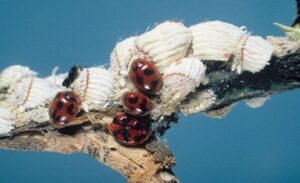
The importation of Vedalia Beetles into California to suppress Cottony Cushion Scales in 1888 was the earliest example of classical biological control in the USA. Was a great success until it became compromised by excessive broad spectrum insecticides.
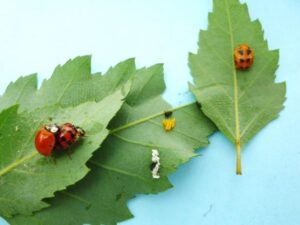
IPM takes advantage of beneficial insects. They are working free of charge. Don’t destroy them needlessly. (Photo Credit: Steven Rettke, Rutgers Coop. Ext.)
Conflict?
Some notable individuals have commented that there are instances where PHC does not equal IPM. They have stated that there may be some practices performed with PHC services that are the antithesis of and have nothing to do with IPM. For example, the fertilization of plants is usually a regularly scheduled practice with PHC. However, when plants are supplemented with N-fertilizers, often the insect populations feeding on the plants will increase (the nitrogen is a desired nutrient for many insects and also increases reproduction rates). Perhaps the most notorious example of the above problem involves the fertilizing of hemlocks when they are infested with hemlock wooly adelgids. Unless the HWA are controlled first, the fertilizing of hemlocks with N causes HWA populations to explode and thus kill the tree faster. Another common example involves cases where spider mite resurgence occurs after fertilizations.
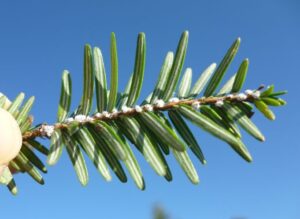
High N-fertilization causes hemlock woolly adelgids to explode. Before fertilizing, control the pest first. (Photo Credit: Steven K. Rettke, Rutgers Coop. Ext.)

High N-fertilization at nursery caused maple spider mites at right to explode. Note the severe chlorotic maple leaf tissues. This mite species is primarily host specific to maple & will not feed on oaks shown at left. (Photo Credit: Steven K. Rettke, Rutgers Coop. Ext.)
Therefore, there are certain services that are done with PHC that will increase the vigor of the plant, but may also increase pest pressures. This obviously is not a “good situation,” but these practices can make a lot of money. This does not mean that PHC is a bad approach for managing plants, however, the practitioner must adapt this service to site-specific problems that may develop over time.
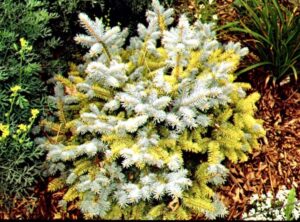
Potassium (K) deficiency in blue spruce needles was caused from excessively wet soils & not from a K-deficiency in the soil. (Photo Credit: Steven K. Rettke, Rutgers Coop. Ext.)
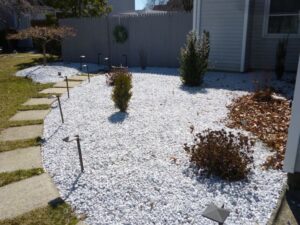
IPM/PHC practices will be limited unless changes are made with the evil white marble stone mulch. (Photo Credit: Steven K. Rettke, Rutgers Coop. Ext.)
Working Together
In conclusion, answering the question as to whether there is an actual difference between IPM and PHC is difficult, because they are so tightly intertwined. Undoubtedly, there are many landscape plant managers who indicate that they provide either PHC or IPM services and yet are essentially performing almost identical practices. Even those that insist that significant differences exist between IPM and PHC should still agree that both philosophies are two approaches that should and can work together. Hence, PHC will assist with your IPM and IPM will assist with your PHC.

Both IPM & PHC require a fine eye when monitoring landscapes to prevent problems & keep plants healthy. (Photo Credit: Steven K. Rettke, Rutgers Coop. Ext.)
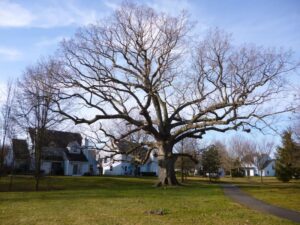
This large, old, majestic white oak will require the PHC skills of an arborist to maintain safety within this residential area. (Photo Credit: Steven K. Rettke, Rutgers Coop. Ext.)
